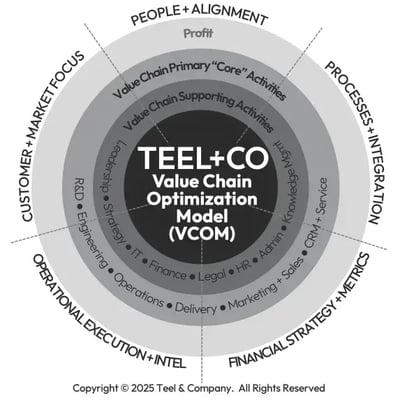Breaking the $10M Barrier:
Why Most Companies Get Stuck
94%
of Companies Will Never Surpass $10M in Annual Revenue¹
Breaking the $10M revenue barrier is not just about selling more—it’s about transforming how a business operates. Most companies struggle because their early-stage growth strategies no longer work at scale. As complexity increases, what once fueled success can now create bottlenecks, inefficiencies, and stagnation.
Why This Happens
As a company grows, interdependencies within business functions increase, creating complexity. The leadership behaviors that launched the company often become misaligned with its evolving needs, leading to stagnation.
The Root Cause
Fragmentation, misalignment, and inefficiencies in the value chain prevent sustainable scaling. Without an integrated financial and operational strategy, businesses struggle to transition from founder-led execution to a scalable enterprise.
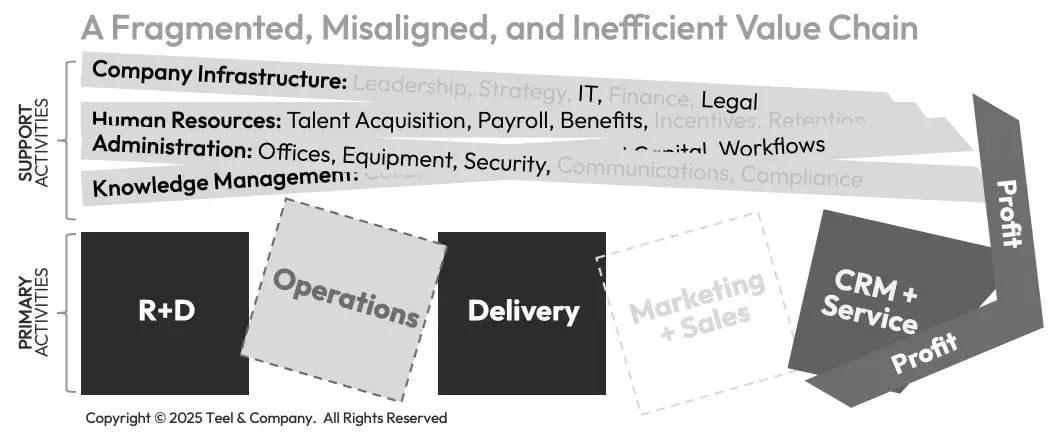
The Consequences

Operational Complexity Becomes Overwhelming
As businesses expand, managing multiple functions, teams, and interdependencies becomes more challenging. Processes that worked in the early stages become inefficient, creating bottlenecks that slow down execution and decision-making.

Leadership Challenges Hinder Scalability
The leadership style that was effective in the company’s early days often fails to meet the needs of a larger, more complex organization. Without adapting to new strategic and managerial demands, growth stalls and momentum is lost.

SG+A Costs Outpace Revenue Growth
As new products and markets are introduced, supporting functions such as sales, marketing, and administration demand additional investment. Without careful financial planning, these expenses can escalate faster than revenue, putting strain on cash flow.

Growth Constraints Force Market Limitations
Scaling sales efforts requires substantial working capital. Many growing businesses struggle to finance expansion, forcing them to either operate within small niches or stagnate due to insufficient resources.
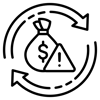
Investors Cannot Exit
Investors expect revenue growth to support their desired valuations and exits. When growth stalls, they become increasingly restless, pushing management to implement aggressive strategies —such as heavy discounting or bundled offerings—to drive short-term sales. This reactive approach often undermines long-term profitability and business stability.
The Reality of Growth Challenges
Sustainable growth requires both strategic execution and financial discipline. Without a strong foundation, companies risk stagnation, inefficiencies, and missed opportunities.
To Overcome These Challenges:

1 Strengthening the Value Chain
is essential to unlocking sustainable growth and improving financial performance.
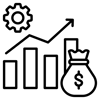
2 Scaling Effectively
requires balancing expansion with disciplined cost management to ensure long-term success.

! Failing to Address
These Constraints
results in significant opportunity costs, limiting growth potential and operational efficiency
Critical Growth Barriers
Leadership, Sales, Financial, Strategy, and Market Positioning
Businesses striving for sustainable growth often face critical barriers that stem from leadership misalignment, financial blind spots, and weak market positioning.
Addressing these barriers requires a holistic approach that strengthens leadership, aligns financial and operational strategies, and refocuses efforts on scalable, market-driven growth.
Scalability Limitations
Definition: The company hasn’t adjusted leadership, processes, and financial strategy to support higher operational demands.
Indicators: Revenue grows, but profitability declines; teams, systems, and processes struggle to scale.
Operational Distractions
Definition: Leadership is consumed by low-value, day-to-day tasks instead of focusing on strategic growth.
Indicators: Executives spend too much time on operations; growth initiatives are deprioritized.
Leadership Bottlenecks
Definition: Decision-making remains centralized, slowing execution and reducing leadership bandwidth for scaling.
Indicators: Slow decision cycles; CEO is involved in every decision; leadership is overloaded.
Financial Visibility Gaps
Definition: The company lacks real-time financial reporting and forecasting, leading to misaligned capital allocation and poor planning.
Indicators: Cash flow surprises; poor budgeting decisions; leadership lacks financial clarity.
Investor Pressure
Definition: Investors push for short-term financial results, forcing leadership into reactionary decisions that hurt long-term scalability.
Indicators: Cost-cutting without growth strategy; pressure to increase quarterly earnings; unsustainable growth decisions.
Sales Focus Drift
Definition: Leadership shifts attention away from sales strategy and customer engagement, weakening client relationships and revenue growth.
Indicators: Declining sales; leadership focuses on internal issues; weak customer relationships.
Weak Market Positioning
Definition: The company lacks clear differentiation, making it difficult to command pricing power and sustain competitive advantage.
Indicators: Price wars erode margins; weak brand identity; struggles to attract ideal customers.
High-Impact Growth Barriers
Scalability, Leadership, Development, and Operational Efficiency
As companies scale, operational complexity increases, requiring strong leadership, streamlined processes, and a well-developed workforce to sustain momentum.
To overcome these barriers, businesses must invest in scalable systems, empower leadership at all levels, and create a structured approach to team alignment and professional development to ensure sustained growth and long-term operational efficiency.
Systems and Process Constraints
Definition: Internal systems, workflows, and SOPs are outdated or unscalable, leading to slow execution and inefficiencies.
Indicators: Manual processes cause delays; poor integration between tools and teams.
Leadership Talent Gaps
Definition: Missing or underdeveloped mid-tier leadership forces executives to micromanage, limiting strategic focus.
Indicators: No leadership pipeline; executives overwhelmed; poor delegation of responsibilities.
Team Misalignment
Definition: Poor role definition and unclear accountability structures create inefficiencies, slowing decision-making and execution.
Indicators: Overlapping responsibilities; decision-making confusion; lack of ownership.
Lack of Talent Development
Definition: No structured career growth, training, or leadership pipeline results in high turnover and skills shortages.
Indicators: High employee churn; lack of internal promotions; employees feel stagnant.
Operational Barriers
Internal Efficiency and Execution
As businesses scale, internal inefficiencies and poor execution can create significant bottlenecks that hinder growth and profitability.
To optimize operations, companies must streamline workflows, integrate data systems, foster cross-departmental collaboration, and implement proactive decision-making frameworks that enhance execution and drive long-term efficiency.
Workflow Bottlenecks
Definition: Key business processes are inefficient, increasing delays and reducing scalability.
Indicators: Repetitive manual work; approval delays; inefficient handoffs.
Disconnected Business Functions
Definition: Lack of integration between finance, sales, operations, and strategy results in inconsistent execution.
Indicators: Departments operate independently; poor alignment on strategic goals; miscommunication between teams.
Data Fragmentation
Definition: Critical insights are spread across multiple systems and departments, preventing leadership from making data-driven decisions.
Indicators: No single source of truth; data discrepancies across teams; slow access to insights.
Overreliance on Outdated Data
Definition: Business decisions are made using historical rather than real-time data, leading to inaccurate forecasting and assumptions.
Indicators: Leadership working off last quarter’s data; delayed responses to market changes.
Siloed Departments
Definition: Lack of cross-functional collaboration lead to miscommunication, redundancies, and inconsistent execution.
Indicators: Poor communication between teams; lack of shared goals; operational inefficiencies.
Reactive Decision-Making
Definition: Leadership waits until problems escalate instead of using data-driven business forecasting for proactive strategy.
Indicators: Constant crisis management; no structured planning process; missed market opportunities.
Execution Inefficiencies
Definition: Slow, inconsistent, or redundant processes prevent the company from capitalizing on market opportunities.
Indicators: Poor coordination across teams; decision-making delays; lack of execution clarity.
Revenue + Competitive Barriers
Retention and Positioning
Sustaining growth requires businesses to retain customers, track meaningful performance metrics, and stay ahead of competitors.
To mitigate these risks, businesses must strengthen customer retention strategies, partner with high-value advisors, implement data-driven KPIs, and develop a systematic approach to competitor analysis and market positioning to maintain their competitive advantage and sustain long-term profitability.
Customer Retention Blind Spots
Definition: No clear strategy for retaining and engaging customers, leading to increased churn and rising acquisition costs.
Indicators: Declining repeat purchases; high churn rates; ineffective customer engagement strategies.
Underperforming Service Providers
Definition: External partners (CPAs, lawyers, consultants) provide transactional support instead of strategic insight, limiting business decision-making.
Indicators: Providers focus only on compliance; no proactive strategic advice; poor ROI on external support.
Ineffective Performance Metrics
Definition: The business relies on vanity metrics instead of KPIs that drive revenue, retention, and scalability, creating a false sense of progress.
Indicators: Focus on superficial numbers; lack of clear performance tracking; misaligned reporting.
Weak Competitive Intelligence
Definition: The company does not systematically track competitors, industry trends, or market shifts, leading to reactive rather than proactive strategy adjustments.
Indicators: Competitors gain market share unnoticed; no structured market monitoring; outdated business strategies.
How to Break Through:
The Teel+Co Value Chain Optimization Model (VCOM)
A well-structured value chain is only as effective as its execution. Leaders must embed accountability, measurement, and continuous improvement into their business model to see sustainable results. Without disciplined follow-through, even the best strategies will fail to deliver meaningful impact.
To achieve scalable sustainable growth, businesses should use the Teel+Co Value Chain Optimization Model (VCOM) to integrate financial and operational strategy across five critical areas:

People + Alignment
Ensure leadership and teams are strategically positioned, service providers deliver high-value insights, and collaboration eliminates silos.

Processes + Integration
Automate workflows while improving cross-functional collaboration to remove inefficiencies and bottlenecks.
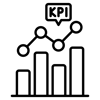
Financial Strategy + Metrics
Develop financial systems that ensure working capital efficiency, data-driven decision-making, and performance tracking.

Operational Execution + Intelligence
Build disciplined management routines with a focus on proactive decision-making and competitive intelligence.
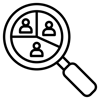
Customer + Market Focus
Foster a culture that prioritizes customer retention, market responsiveness, and long-term strategic growth.
The Expected Outcomes
By eliminating fragmentation, strengthening financial and operational strategy, and embedding competitive intelligence into operations, companies significantly increase their probability of surpassing the $10M revenue barrier.
This transformation enhances decision-making with real-time performance tracking, improves customer retention through a market-responsive approach, and optimizes resource allocation for sustained profitability.
As a result, businesses establish a scalable foundation that not only fuels long-term growth but also builds investor confidence and competitive market positioning.


Are You Ready to Break Through Your Company's Growth Ceiling?
Teel+Co partners with businesses to implement scalable financial and operational strategies that drive sustainable success.
Contact us to take the next step and let's start building your path beyond $10 million today.
¹ Source: Cespedes, Frank V., Dougherty, James. P., & Skinner III, Ben S., “How to Identify the Best Customers for Your Business,” MIT Sloan Management Review 54, No. 2 (2013): 1. Concepts from this article have been paraphrased and expanded upon to develop original insights tailored to business strategy and growth challenges.

